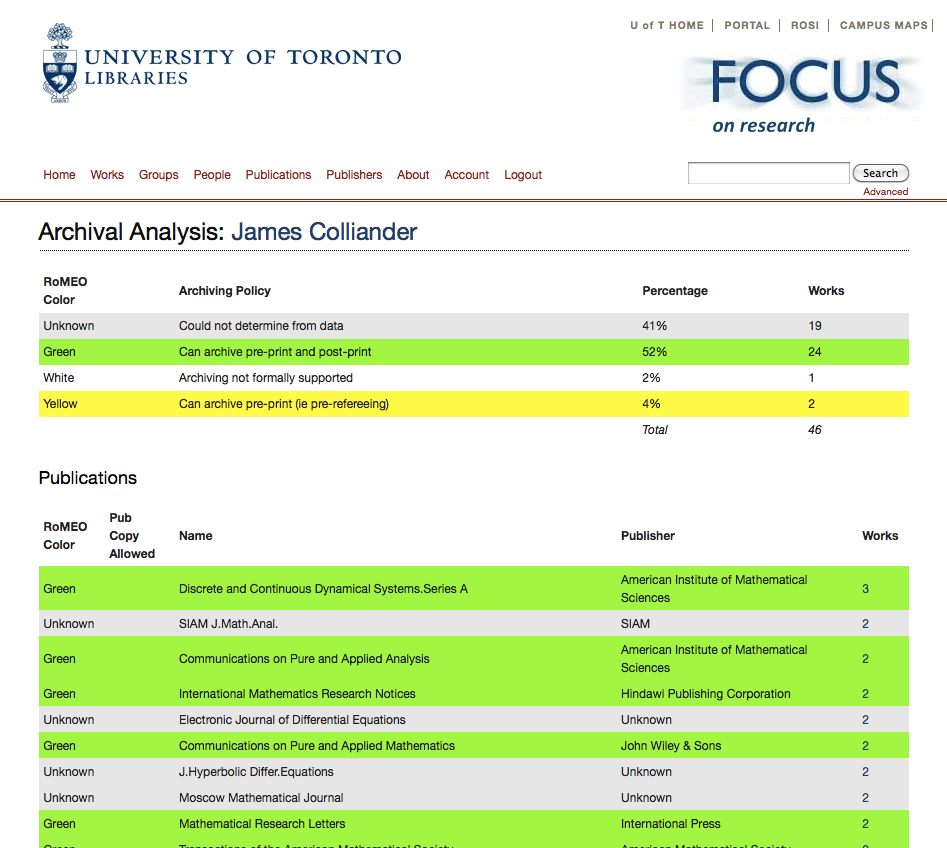Mathematics and the Library at the University of Toronto
Overview
UTL has built, and is in the process of expanding, a suite of web-based tools that have the potential to revolutionize the research driven by scholars at the University of Toronto. Some of these tools are designed to open the library’s archival system to new content streams generated within the University’s daily research activities. Other tools provide new methods to collect, share and discuss library resources enabling new ways to collaborate and develop research ideas. The technologies underpinning these advances are already in place or soon to be deployed. The next main challenge is the principal obstruction: we need to stimulate the researchers to use them. My view is that they won’t unless they see a payoff for their research goals.New tools and their potential
A quick summary of web-based resources provided by UTL organized along four key categories:- Archival
- Scholarship
- Collaboration
- Broadcast
Archival
The library’s tspace is an online repository for storing content generated by the University of Toronto. This resource is a bit like arXiv but localized to UofT and it is open to a wider variety of content types (movies, scans of hand-written notes, etc.) than arXiv. Once uploaded to tspace, the content is permanently archived, given an immutable web location address and is strategically exposed to web search engines. All PhD theses produced here end up on tspace. The library wants scholars to upload preprint and postprint versions of published papers to tspace. Notes should be uploaded to tspace enabling researchers to later make references to the ideas emerging from seminars, etc. The remarkable feature of tspace is that it enables UofT researchers to directly influence the Library’s collection. However, the success of the tspace repository is limited without the active participation by UofT researchers who are plenty busy with other tasks.Scholarship
The library has piloted and will soon deploy BibApp, a web gateway organizing library content around the scholars at UofT who produced it. (Here is my page inside the test server.) BibApp’s database of citations is automatically filled (with UTL sometimes doing massive amounts of data cleaning) using content streams from resource amalgamators like Scholar’s Portal. However, BibApp also leverages the expertise of the scholar’s who appear inside BibApp by allowing them to edit and improve BibApp’s content about their scholarship. The application shows scholars information about the copyright restrictions of their published works:
Those references which appear green can be enriched with postprint and preprint versions of the published work. BibApp will be intertwined with tspace so that uploads into tspace can take place within the BibApp pages.
Collaboration
Peter Clinton reports to me that the library will soon provide storage space enabling faculty to build and share citation collections through zotero. Zotero provides rapid collection of reference data on published works, preprints on arXiv, web pages, etc. and stores the collected data in a database that is accessible through the web. Each citation is stored inside a container into which other data can be developed. This technology allows for precise exchanges of ideas to take place among the references shared by a group of scholars. This can be extremely useful for a research group led by a UofT faculty member or for a broader group of researchers with similar interests.Broadcast
The library has invested in broadcast video streaming technology and built MyMedia. MyMedia is UofT’s version of youtube. Videos generated by UofT faculty can be uploaded in their native format. The MyMedia server converts and makes available the video content in various formats so that the content can be watched on iPhone, Android, through a web browser, etc. The library has also made recording and screen capture technologies available to UofT faculty so it is easy to generate video content for instruction and research purposes.But, will people use this technology?
The technology is in place. However, the experience of libraries across the world over the past ten years building these types of tools spawns a common observation: to make it really work requires changing the behavior of people.UTL and Toronto Math share some resources. These resources will be deployed in pilot programs to encourage and make it easier for math faculty to take advantage of the Library’s technologies. The shared resources should be spent strategically to create short term examples that mathematicians can recognize as valuable within their research plans. We need examples that show how these tools enhance the research potential of faculty-led research groups to inspire adoption of the technology into the daily work flow of researchers at UofT. Updates to follow….